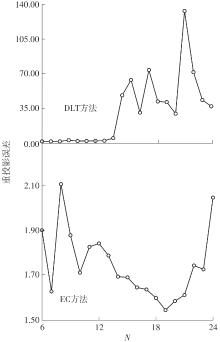| 1 |
YAO S, GUAN R, HUANG X,et al .Radar-camera fusion for object detection and semantic segmentation in autonomous driving:a comprehensive review[J].IEEE Transactions on Intelligent Vehicles,2024,9(1):2094-2128.
|
| 2 |
ZHOU Y, LIU L, ZHAO H,et al .Towards deep radar perception for autonomous driving:datasets,methods,and challenges[J].Sensors,2022,22(11):4208/1-45.
|
| 3 |
HAN Z, WANG J, XU Z,et al .4D millimeter-wave radar in autonomous driving:a survey[EB/OL].(2023-06-07)[2024-04-01]..
|
| 4 |
林永杰,陈宁,卢凯 .基于毫米波雷达点云的路口车辆轨迹跟踪方法[J].华南理工大学学报(自然科学版),2023,51(10):110-125.
|
|
LIN Yongjie, CHEN Ning, LU Kai .Vehicle trajectory tracking at intersections based on millimeter wave radar point cloud[J].Journal of South China University of Technology(Natural Science Edition),2023,51(10):110-125.
|
| 5 |
SINGH A .Vision-radar fusion for robotics BEV detections:a survey[C]∥ Proceedings of 2023 IEEE Intelligent Vehicles Symposium.Anchorage:IEEE,2023:10186647/1-7.
|
| 6 |
XIONG W, LIU J, HUANG T,et al .LXL:LiDAR excluded lean 3D object detection with 4D imaging radar and camera fusion[J].IEEE Transactions on Intelligent Vehicles,2024,9(1):79-92.
|
| 7 |
ZHENG L, LI S, TAN B,et al .RCFusion:fusing 4-D radar and camera with bird’s-eye view features for 3D object detection[J].IEEE Transactions on Instrumentation and Measurement,2023,72:8503814/1-14.
|
| 8 |
DOMHOF J, KOOIJ J F P, GAVRILA D M .An extrinsic calibration tool for radar,camera and lidar[C]∥ Proceedings of 2019 International Conference on Robotics and Automation.Montreal:IEEE,2019:8107-8113.
|
| 9 |
ZHANG J, ZHANG S, PENG G,et al .3DRadar2ThermalCalib:accurate extrinsic calibration between a 3D mmWave radar and a thermal camera using a spherical-trihedral[C]∥ Proceedings of 2022 IEEE the 25th International Conference on Intelligent Transportation Systems.Macau:IEEE,2022:2744-2749.
|
| 10 |
KIM D, KIM S .Extrinsic parameter calibration of 2D radar-camera using point matching and generative optimization[C]∥ Proceedings of 2019 the 19th International Conference on Control,Automation and Systems.Jeju:IEEE,2019:99-103.
|
| 11 |
LIU M, LI D, LI Q,et al .An online intelligent method to calibrate radar and camera sensors for data fusing[J].Journal of Physics:Conference Series,2020,1631:012183/1-9.
|
| 12 |
SHEENY M, DE PELLEGRIN E, MUKHERJEE S,et al .RADIATE:a radar dataset for automotive perception in bad weather[C]∥ Proceedings of 2021 IEEE International Conference on Robotics and Automation.Xi’an:IEEE,2021:5617-5623.
|
| 13 |
SCHÖLLER C, SCHNERRLER M, KRÄMMER A,et al .Targetless rotational auto-calibration of radar and camera for intelligent transportation systems[C]∥ Proceedings of 2019 IEEE Intelligent Transportation Systems Conference.Auckland:IEEE,2019:3934-3941.
|
| 14 |
WANG X Y, WANG X S, ZHOU Z Q .A high-accuracy calibration method for fusion systems of millimeter-wave radar and camera[J].Measurement Science and Technology,2022,34(1):015103/1-14.
|
| 15 |
CUI H, WU J, ZHANG J,et al .3D detection and tracking for on-road vehicles with a monovision camera and dual low-cost 4D mmWave radars[C]∥ Procee-dings of 2021 IEEE International Intelligent Transportation Systems Conference.Indianapolis:IEEE,2021:2931-2937.
|
| 16 |
OH J, KIM K S, PARK M,et al .A comparative study on camera-radar calibration methods[C]∥ Proceedings of 2018 the 15th International Conference on Control,Automation,Robotics and Vision.Singapore:IEEE,2018:1057-1062.
|
| 17 |
CHENG L, SENGUPTA A, CAO S .3D radar and camera co-calibration:a flexible and accurate method for target-based extrinsic calibration[C]∥ Proceedings of 2023 IEEE Radar Conference.San Antonio:IEEE,2023:10149669/1-6.
|
| 18 |
WISE E, PERŠIC J, GREBE C,et al .A continuous-time approach for 3D radar-to-camera extrinsic calibration[C]∥ Proceedings of 2021 IEEE International Conference on Robotics and Automation.Xi’an:IEEE,2021:13164-13170.
|
| 19 |
WIES E, CHENG Q, KELLY J .Spatiotemporal calibration of 3-D millimetre-wavelength radar-camera pairs[J].IEEE Transactions on Robotics,2023,39(6):4552-4566.
|
| 20 |
GAO D, DUAN J, YANG X,et al .A method of spatial calibration for camera and radar[C]∥ Proceedings of 2010 the 8th World Congress on Intelligent Control and Automation.Jinan:IEEE,2010:6211-6215.
|
| 21 |
WANG T, ZENG N, XIN J,et al .Integrating millimeter wave radar with a monocular vision sensor for on-road obstacle detection applications[J].Sensors,2011,11(9):8992-9008.
|
| 22 |
ZHOU Y, DONG Y, HOU F,et al .Review on millimeter-wave radar and camera fusion technology [J].Sustainability,2022,14(9):5114/1-32.
|
| 23 |
JI Z, PROKHOROV D .Radar-vision fusion for object classification[C]∥ Proceedings of 2008 the 11th International Conference on Information Fusion.Cologne:IEEE,2008:1-7.
|
| 24 |
Inc GitHub .OpenCV:open source computer vision library[EB/OL].(2022-12-28)[2024-04-01]..
|
| 25 |
LEE C L, HSUEH Y H, WANG C C,et al .Extrinsic and temporal calibration of automotive radar and 3D LiDAR[C]∥ Proceedings of 2020 IEEE/RSJ International Conference on Intelligent Robots and Systems.Las Vegas:IEEE,2020:9976-9983.
|
| 26 |
AGRAWAL S, BHANDERI S, DOYCHEVA K,et al .Static multitarget-based autocalibration of RGB cameras,3-D rada,and 3-D lidar sensors[J].IEEE Sensors Journal,2023,23(18):21493-21505.
|























